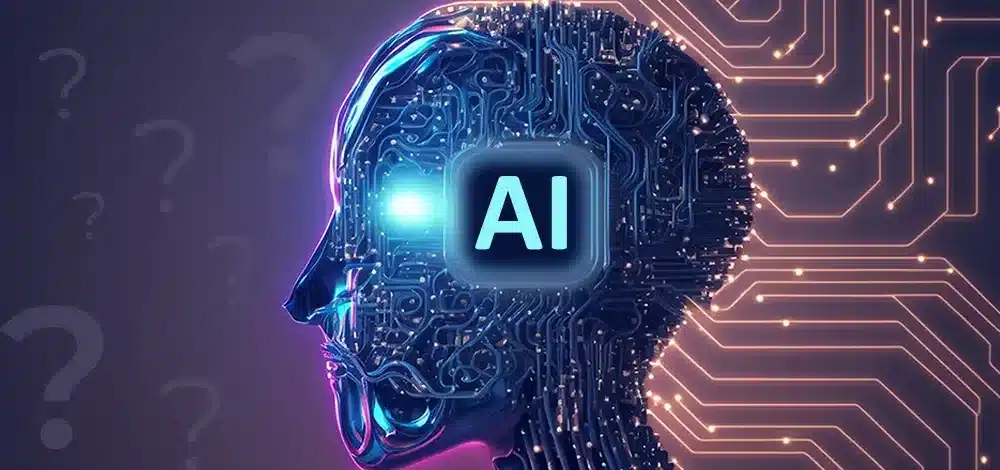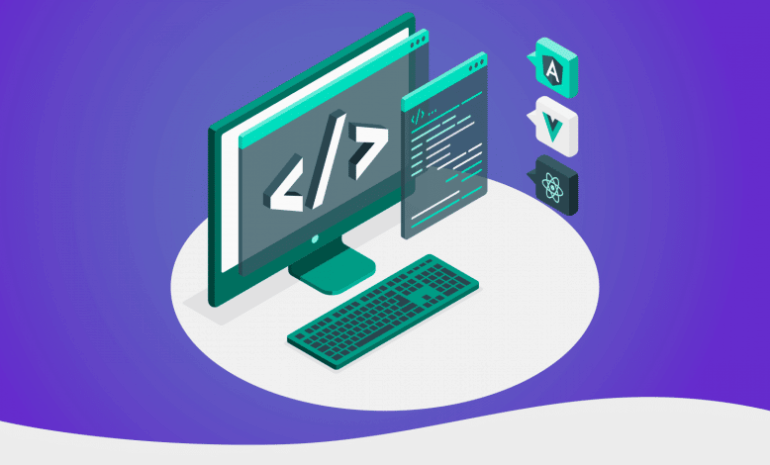Artificial intelligence (AI) is a multidisciplinary field of computer science that focuses on designing systems capable of simulating human cognitive functions that enable machines to perform tasks requiring human intelligence. AI encompasses machine learning, which uses algorithms and statistical models to learn from:
- Data
- Natural language processing
- Computer vision
- Robotics
- Expert systems
AI seeks to develop intelligent agents that perceive, reason, learn, plan, and act independently or in collaboration with humans, transforming diverse industries and shaping the future of technology.
Artificial Intelligence Explained
Artificial intelligence (AI) is a rapidly evolving field encompassing techniques, algorithms, and applications to create intelligent agents capable of mimicking human cognitive abilities — abilities like learning, reasoning, planning, perceiving, and understanding natural language. Though it’s only recently become mainstream, AI applications are everywhere. We encounter them in virtual assistants, chatbots, image classification, facial recognition, object recognition, speech recognition, machine translation, and robotic perception.
As a field of study, AI encompasses areas such as machine learning, natural language processing, computer vision, robotics, and expert systems.
Machine Learning
At the core of AI is machine learning, a subset that leverages algorithms and statistical models to enable systems to learn from and adapt to data inputs without explicit programming. Techniques like supervised, unsupervised, and reinforcement learning enable machines to identify patterns, make predictions, and optimize decision-making based on data.
- Supervised Learning: This involves training an algorithm on a labeled dataset, which means that each input data point is paired with an output label. Supervised learning algorithms are designed to learn a mapping from inputs to outputs, ideal for applications like spam detection or image recognition.
- Unsupervised Learning: In contrast to supervised learning, unsupervised learning algorithms are given no labels, relying instead on the intrinsic structure of the data to draw insights. It’s used for clustering, association, and dimensionality reduction tasks.
- Semi-supervised and Reinforcement Learning: These forms leverage both labeled and unlabeled data, which can enhance learning efficiency and accuracy.
Natural Language Processing (NLP)
Natural language processing (NLP) equips AI systems with the ability to understand, interpret, generate, and interact with human languages. NLP techniques facilitate tasks like sentiment analysis, language translation, and chatbot development.
Computer Vision
Computer vision focuses on enabling machines to perceive, recognize, and interpret visual information from the surrounding environment. This discipline involves object recognition, facial recognition, and scene understanding, which are critical for applications such as autonomous vehicles and surveillance systems.
Robotics
Robotics integrates AI with mechanical, electrical, and control engineering to design, build, and program robots capable of performing complex tasks autonomously or semi-autonomously. Robots can range from industrial manipulators to humanoid assistants, leveraging AI for navigation, manipulation, and interaction with humans and their environment.
Expert Systems
Expert systems, a branch of AI, involve the development of rule-based systems that emulate human expertise in specific domains. Expert systems are used to provide recommendations, diagnoses, or decision support based on a set of predefined rules and a knowledge base.
Brief History of AI Development
- 1950s-1960s: Early AI research and the Dartmouth Conference
- 1970s-1980s: Expert systems and the first AI winter
- 1990s-2000s: Machine learning advances and the second AI winter
- 2010s-present: Deep learning revolution, big data, and increased computing power
Artificial Intelligence has a rich and complex history dating back to the mid-20th century. The field was born out of the convergence of cybernetics, logic theory, and cognitive science. In 1956, the Dartmouth Conference marked the official birth of AI as a field of study. Led by John McCarthy, Marvin Minsky, Nathaniel Rochester, and Claude Shannon, this event set the stage for decades of research and development.
The 1960s and early 1970s saw significant optimism and progress. Researchers developed programs that could solve algebraic problems, prove logical theorems, and even engage in rudimentary conversations in English. Nonetheless, enthusiasm waned with the realization that many AI problems were more complex than initially thought.
The late 1970s and 1980s witnessed the rise of expert systems — AI programs designed to emulate the decision-making ability of human experts in specific domains. These systems found applications in fields like medical diagnosis and geological exploration. Despite some successes, limitations in scalability and adaptability led to decreased funding and interest, a period known as the “AI winter.”
The 1990s and early 2000s saw a shift towards more data-driven approaches. Machine learning techniques, which enable computers to improve their performance on a task through experience, gained traction. Progress was still relatively slow, though, leading to a second AI winter.
The current AI renaissance began in the 2010s, driven by three key factors: the availability of big data, significant increases in computing power, and breakthroughs in deep learning algorithms. The convergence led to remarkable advances in areas such as computer vision, natural language processing, and robotics. AI systems now outperform humans in various tasks, from image recognition to complex strategy games like Go.
Today, AI is not just a subject of academic research but a transformative force in industry and society. As we stand on the cusp of even more significant breakthroughs, understanding the historical context of AI development is crucial for appreciating both its potential and its risks.
Types of AI
Artificial Intelligence can be broadly categorized into two main types: Narrow AI and General AI. Understanding these categories unlocks a greater understanding of the current state of AI technology and its potential future developments.
Narrow AI (Weak AI)
Narrow AI, also known as Weak AI, refers to AI systems designed and trained for a specific task or a narrow range of tasks. These systems excel within their defined parameters but lack the ability to transfer their intelligence to other domains or tasks outside their specific focus.
Examples of Narrow AI are ubiquitous in our daily lives. Virtual assistants like Siri or Alexa can interpret voice commands and perform specific tasks such as setting reminders or playing music. Image recognition systems can identify objects or faces in photographs with high accuracy. Recommendation algorithms on platforms like Netflix or Amazon suggest content or products based on user preferences and behavior.
While incredibly useful and often impressive in their performance, Narrow AI systems are limited to their programmed functions. They don’t possess genuine understanding or consciousness and can’t adapt to entirely new situations without being reprogrammed or retrained.
General AI (Strong AI)
General AI, also referred to as Strong AI or Artificial General Intelligence (AGI), is a hypothetical type of AI that would possess human-like cognitive abilities. Such a system would be capable of understanding, learning, and applying knowledge across a wide range of domains, much like a human brain.
Key characteristics of General AI would include:
- The ability to reason, plan, and solve problems in various contexts
- Learning and adapting to new situations without specific programming
- Understanding and generating natural language
- Formulating original ideas and demonstrating creativity
- Self-awareness and consciousness (though this is debated)
It’s important to note that General AI remains purely theoretical at this point. Despite significant advances in AI technology, we are still far from creating a system that truly mimics human-level intelligence across all domains. The development of AGI poses numerous technical challenges and raises profound philosophical and ethical questions.
The distinction between Narrow and General AI is crucial in the context of risk management. While Narrow AI systems present immediate and concrete risks that need to be managed, the potential development of General AI introduces a range of long-term, existential considerations that are more speculative but potentially more impactful.
As AI technology continues to advance, the line between Narrow and General AI may become increasingly blurred. Some researchers propose the concept of “Artificial Narrow Intelligence+” or “Artificial General Intelligence-” to describe systems that demonstrate capabilities beyond traditional Narrow AI but fall short of full General AI.
The Interdependence of AI Techniques
Machine learning, deep learning, and natural language processing have become increasingly intertwined, with each subfield complementing the others to create more sophisticated AI systems.
For example, deep learning techniques, such as convolutional neural networks (CNNs) and recurrent neural networks (RNNs), have been applied to computer vision and NLP tasks, leading to state-of-the-art performance in image classification and machine translation. Similarly, transformer architectures have revolutionized natural language processing by significantly improving the performance of tasks such as machine translation, information extraction, sentiment analysis, and question answering. The combination of probabilistic methods, such as Bayesian networks and expectation-maximization algorithms, with machine learning approaches has provided powerful tools for handling uncertainty and making data-driven decisions.
The fusion of reinforcement learning, computer vision, and control algorithms enables robots to learn complex behaviors, navigate dynamic environments, and interact with objects. Expert systems showcase the interdependence of AI techniques through the integration of knowledge representation, inference engines, and machine learning.
By combining these components, expert systems can reason, learn, and adapt to new information, making them valuable tools for decision-making in various domains.
Revolutionizing Industries
AI has made significant strides in various domains, transforming industries and the way we live, work, and interact.
Healthcare
AI has made remarkable advancements in healthcare, enabling early disease detection, personalized treatment plans, and improved patient outcomes. Deep learning algorithms, particularly convolutional neural networks (CNNs), have been instrumental in enhancing medical imaging analysis for diagnosing diseases such as cancer and Alzheimer’s.
Natural language processing techniques have empowered the extraction of vital information from electronic health records and scientific literature, streamlining medical research and decision-making. Additionally, AI-driven drug discovery platforms have accelerated the development of new pharmaceuticals, reducing the time and cost of bringing life-saving medications to market.
Finance
The financial sector has harnessed AI to optimize trading strategies, detect fraud, manage risk, and improve customer service. Most of us have experienced streamlined support or received personalized financial advice from AI-driven chatbots and virtual assistants.
Machine learning algorithms, such as support vector machines and decision trees, enable automated trading systems to analyze vast quantities of data and execute trades with precision and speed. AI-powered fraud detection systems leverage anomaly detection and pattern recognition techniques to identify suspicious activities, enhancing security and mitigating loss.
Transportation
AI has transformed the transportation industry through the development of autonomous vehicles, traffic management systems, and route optimization algorithms. Machine learning techniques, computer vision, and sensor fusion enable self-driving cars to perceive and navigate complex environments, promising to reduce accidents and improve traffic flow.
AI-driven traffic management systems analyze real-time traffic data and predict congestion patterns, optimizing traffic signal timings and reducing commute times. Route optimization algorithms, powered by AI, help logistics companies and delivery services minimize fuel consumption and improve efficiency.
Education
AI has the potential to revolutionize education through personalized learning, intelligent tutoring systems, and automated grading. Machine learning algorithms analyze students’ learning patterns, preferences, and progress, tailoring educational content to optimize learning outcomes. Intelligent tutoring systems provide individualized feedback, guidance, and support, bridging the gap between students and instructors. AI-driven grading systems can assess essays and other complex assignments, saving time for educators and providing students with timely, consistent feedback.
Manufacturing
AI has been instrumental in modernizing manufacturing processes, enhancing productivity, and reducing waste. Machine learning algorithms enable predictive maintenance, identifying potential equipment failures before they occur and reducing downtime. Computer vision systems, powered by deep learning, facilitate automated quality control, ensuring the accuracy and consistency of manufactured products. AI-driven supply chain optimization platforms analyze demand forecasts, inventory levels, and production schedules, streamlining operations and minimizing costs.
Entertainment and Media
AI has reshaped the entertainment and media landscape by enabling content personalization, recommendation systems, and creative applications. Machine learning algorithms analyze user preferences, behavior, and demographics to curate personalized content and recommendations, enhancing user engagement and satisfaction. Generative AI techniques, such as generative adversarial networks (GANs) and transformer architectures, have empowered the creation of novel art, music, and storytelling experiences, expanding the boundaries of human creativity.
Challenges and Opportunities in AI Research
Despite the significant progress made in AI, several challenges remain. One of the main challenges is developing AI systems that can exhibit general intelligence (i.e., the ability to learn and reason across a wide range of tasks and domains). Current AI systems are often specialized for specific tasks, and transfer learning techniques are still in their infancy. Moreover, the development of AI systems that can explain their reasoning and decisions, a crucial requirement for many applications, remains an open problem.
Ethical Deployment of AI Systems
Another challenge is ensuring the ethical and safe deployment of AI systems. Issues such as data privacy, algorithmic bias, and the impact of AI on employment have raised concerns among researchers, policymakers, and the public. These concerns highlight the importance of incorporating ethical and safety considerations in AI research and development.
AI-Powered Threats to Cloud Security
AI introduces several challenges to cloud security, with some of the most pressing issues arising from adversarial attacks, data privacy concerns, model complexity, AI-based cyberthreats, and resource consumption attacks.
Adversarial Attacks
AI systems, particularly deep learning models, are vulnerable to adversarial examples, which are inputs crafted to deceive the model into producing incorrect outputs. In a cloud environment, attackers can exploit these vulnerabilities to compromise AI services, leading to incorrect predictions, unauthorized access, or data manipulation.
Data Privacy and Confidentiality
Data privacy and confidentiality pose another challenge, as AI models often require massive amounts of data for training, which may include sensitive user information. Storing and processing this data in the cloud raises privacy concerns, as unauthorized access or data breaches can result in the exposure of sensitive information. Additionally, AI models can inadvertently leak confidential data through model inversion or membership inference attacks.
Model Complexity and Interpretability
The complexity of AI models, particularly deep learning and ensemble methods, challenges cloud security, as their lack of interpretability makes it difficult to assess security properties and identify vulnerabilities. This, in turn, hinders the detection and mitigation of potential attacks on AI services.
AI-Based Cyberthreats
Attackers can leverage AI techniques to develop more sophisticated cyberthreats, such as intelligent malware and automated vulnerability exploitation. These AI-enhanced attacks can be harder to detect and defend against in a cloud environment, posing significant challenges to traditional security measures.
Resource Consumption Attacks
AI models, particularly deep learning, require substantial computational resources for training and inference. Attackers can exploit this by launching resource consumption attacks, such as denial of service (DoS) or distributed denial of service (DDoS), targeting AI services in the cloud and causing performance degradation or service disruption.
To address these challenges, cloud security strategies must adopt a holistic approach that encompasses robust AI model design, secure data management practices, and advanced threat detection and mitigation techniques. This includes the development of secure AI frameworks, privacy-preserving data processing methods, and the continuous monitoring and assessment of AI services in the cloud.
Using AI to Defend the Cloud
AI can greatly enhance cloud security by improving capabilities that help maintain the confidentiality, integrity, and availability of cloud services while addressing the evolving challenges of the cloud security landscape.
By utilizing machine learning algorithms to analyze data generated in the cloud, AI can improve threat detection and identify patterns and anomalies that may indicate security threats. AI-driven security tools are capable of detecting unusual user behavior, network traffic, or system events and flagging them for further investigation. Real-time identification of threats, such as malware, data breaches, or unauthorized access, can substantially reduce the potential damage caused by these attacks.
In addition to threat detection, AI can streamline and automate incident response, minimizing the need for human intervention. Cloud security systems that leverage AI algorithms can automatically take corrective actions, such as isolating affected systems, blocking malicious IP addresses, or revoking compromised credentials. Automating incident response not only reduces response time but also mitigates the risk of human error, enhancing cloud security posture.
AI can also reinforce data privacy and confidentiality by employing privacy-preserving data processing techniques, such as differential privacy, homomorphic encryption, and secure multiparty computation. These methods allow AI models to learn from encrypted or anonymized data, ensuring sensitive information remains protected while still benefiting from AI-driven insights.
AI contributes to system resilience by continuously monitoring and adapting to the evolving threat landscape. AI-driven security solutions can learn from past incidents and adjust their behavior, updating detection models as needed. This adaptability enables cloud security systems to proactively defend against emerging threats and adjust to the changing tactics of malicious actors.
Artificial Intelligence Security Posture Management (AI-SPM)
The growing complexity of threats, advancements in AI technology, and changes in the IT landscape, has given rise to AI-SPM. As AI continues to evolve and mature, its role in managing and improving security posture is likely to become even more significant.
AI-SPM — or artificial intelligence security posture management — refers to the application of artificial intelligence techniques to manage and improve the security posture of an organization’s IT infrastructure. AI-SPM’s approach involves using AI algorithms to analyze, monitor, and respond to potential security threats, vulnerabilities, and risks in real-time.
Key Components of AI-SPM
Anomaly detection: AI algorithms can analyze large quantities of data, such as logs or network traffic, to detect unusual patterns and behaviors that may indicate security threats.
Vulnerability management: AI can help organizations identify and prioritize vulnerabilities in their IT infrastructure, enabling them to take proactive measures to remediate risks.
Incident response automation: AI can streamline the incident response process, automatically taking corrective actions when a security threat is detected, reducing response time, and mitigating the risk of human error.
Risk assessment: AI can help organizations assess and quantify their cybersecurity risks, enabling them to make data-driven decisions about their security strategy and resource allocation.
Continuous monitoring and adaptation: AI-driven security solutions can learn from incidents and adapt their behavior to defend against emerging threats and changing tactics of malicious actors.
The Future of AI
As AI continues to advance, we can expect to see more sophisticated applications and systems that leverage the full potential of machine learning, deep learning, natural language processing, computer vision, and robotics. Researchers are working toward developing AI systems that can learn and reason like humans, leading to more general and adaptable intelligence. The integration of AI techniques and the development of systems that can address ethical and safety concerns will play a critical role in ensuring the responsible and beneficial deployment of AI across various domains.







